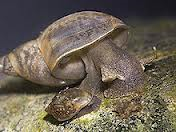Attraction of eyestalk ablated Lymnaea acuminata towards the different photo and chemo stimulants
Keywords:
Lymnaea acuminata; eye ablation; uninfected and infected snails; wavelength; time; monochromatic lightAbstract
In the eye of Lymnaea acuminata cornea, lens, microvillar layer, pigmented layer, cell layer and photoreceptors works in well organized manner and respond to photic stimulation. In the present study attraction of eye stalk ablated snail Lymnaea acuminata towards the different visible monochromatic light was studied. The photosensitivity of snails to different monochromatic light was wavelength as well as time dependent. In left or right eye stalk ablated snails response to monochromatic light was noted after 3 and 7 days of ablation. However, when both eyes were ablated the response to photic stimulation was observed after 9 days. This functional recovery indicates that type and number of photoreceptors as well as their regenerative capacity are not same in left and right eye of uninfected and infected snails. Sixty minute exposure of red light+ serine as chemo stimulant in bait, caused maximum attraction of snails (62%) than single exposure of chemo (36%) or red (26%) light stimulus.
References
Agarwal, R.A., Singh, D.K., 1988. Harmful gastropods and their control. Acta Hydrochim. Hydrobiol., 16, 113-138.
Bicker, G., Davis, W.T., Matera, E.M., Kovac, M.P., Stormogipson, D.J., 1982. Chemoreception and mechanoreception in the gastropod mollusk Pleurobranchaea californica.1. Extracelluler analysis of afferent pathways. J. comp. physiol, 149, 221-234.
D’Asaro, C.N., 1969. A comparative embryogenesis and early organogenesis of Bursa corrugate and Distorsita clathrata. Malacologia 9, 349-389.
Debbie, S.R., Dened, K., John, T.S., 2006. Lethal and sub- lethal effects of UVB on juvenile Biomphalaria glabrata (Mollusca: Pulmonata). J Invert Pathol 93(3), 192- 200.
Gordon, L.F., Hardie, R., Simone, B.L., 2010. Phototransduction and the evolution of photoreceptors. Curr Biol 20(3), R114- R124.
Moffett, S., Austin, R. Daniel. 1981. Implanted cerebral ganglia produce supernumerary eyes and tentacles in host snails. J. Exp. Zool. 216(2), 321- 325.
Sahley, C., Crow, T., 1998. Invertebrate learning: current perspectives In: Neurobiology of learning and memory. San Deigo, CA: Academic press.
Sakakibara, M., Aritaka, T., Iizuka, A., Suzuki, H., Horikoshi, T., Lukowiak, K., 2005. Electrophysiological responses to light of neurons in the eye and statocyst of Lymnaea stagnalis, J. Neurophysiol, 93, 493–507.
Singh, A., Singh, D.K., Mishra, T.N., Agarwal, R.A., 1996. Molluscicide of plant origin. Biol. Agric. Hortic. 13, 205–252.
Singh, O., Agarwal, R.A., 1981. Toxicity of certain pesticides to two economic species of snails in northern India. J Econ Entomol. 14, 568-571.
Singh, S.K., Kumar. P., Singh, V.K., Singh, D.K., 2010. Manipulated oviposition in fresh water snail Lymnaea acuminata through hydrogen Peroxide (H2O2). Middle- East Journal of Scientific Research 6(3), 213- 218.
Sokal, R.R., Rohlf, F.J., 1973. Introduction to biostatistics, freeman, W.H. San Francisco.
Srivastava, A.K., Singh, D.K., Singh, V.K., 2013. Abiotic factors and anti- reproductive action of bait containing eugenol against Lymnaea acuminata. Scientific journal of biological sciences 2(4), 76-85.
Tripathi, N., 1994. Studies on the eye and tentacle regeneration and their role in regulation of reproduction in the freshwater snail Lymnaea acuminata, Ph. D. Thesis, Department of Zoology, University of Gorakhpur, India.
Tiwari, F., Singh, D.K., 2004. Behavioural responses of the snail Lymnaea acuminata to carbohydrates in snail attractant pellets; Naturwissenschaften, 91 (8), 378-380.
Zieger, M., Meyer- Rochow, V. B., 2008. Understanding the cephalic eyes of pulmonate gastropods: A review. American Malacological Bulletin 26, 47-66.

Published
How to Cite
Issue
Section
Copyright (c) 2013 D.K. Singh, A.P. Tripathi

This work is licensed under a Creative Commons Attribution-NonCommercial-NoDerivatives 4.0 International License.



